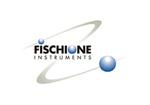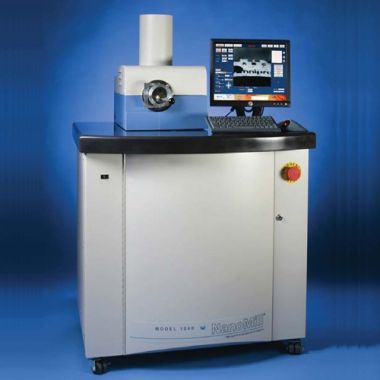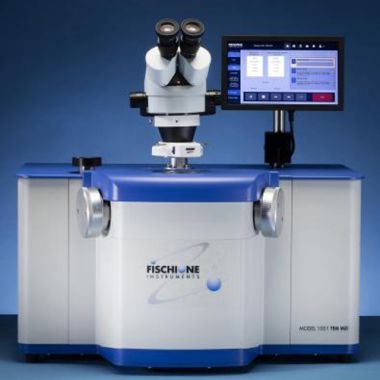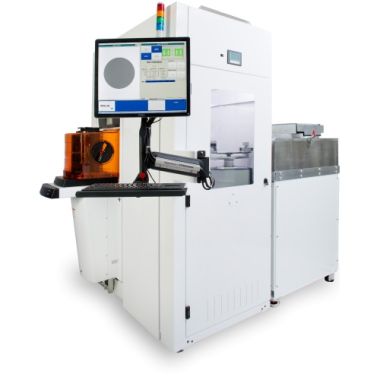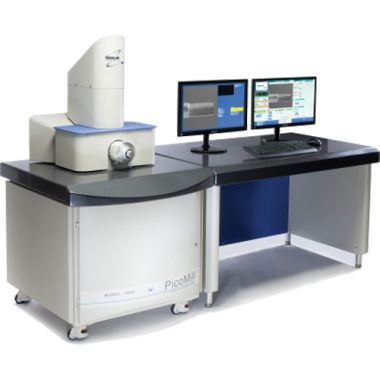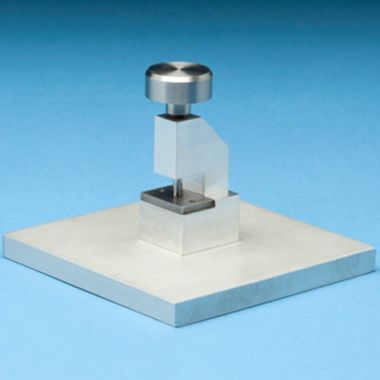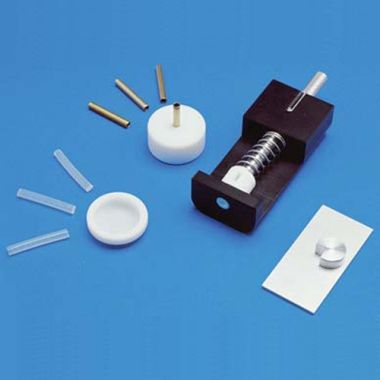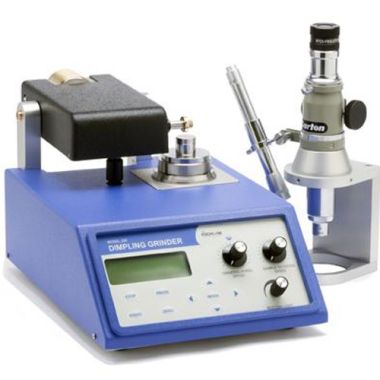Fischione Model 1061 SEM Mill (Ion Milling)
-
Minimal maintenance -
Due to the efficiency of ionization, maintenance of the TrueFocus ion source is minimal and the components have an extremely long life. Material sputtered from the ion source is negligible, minimizing both sample contamination and component maintenance. Automated shuttering prevents the buildup of sputtered material on the viewing window. All system components are easily accessible for routine cleaning. - Programmable - Sample rotation is 360° with variable rotation speed and a sample rocking feature. The instrument automatically senses the sample thickness and establishes the milling plane, which maximizes throughput. A magnetic encoder provides absolute positioning accuracy.
- Automatic termination - The ion milling process can be automatically terminated by elapsed time or by temperature.
- Time - A timer allows milling to continue for a predetermined time and then turns off the energy to the ion sources when the time has elapsed. The sample remains under vacuum until the load lock is vented.
- Temperature - The thermal safeguard associated with the sample cooling system will stop the process if the sample stage reaches a preset temperature.
Cross-section station (optional)
A tool for creating pristine cross-section samples ready for ion milling in the SEM Mill. The station is designed to accommodate a wide range of sample sizes and enables precise positioning of the area of interest and can be used with a wide variety of materials, including semiconductor devices, multilayers, ceramics, and hard/brittle materials.
In situ sample viewing
The ion milling process can be monitored in situ in the milling position when using either the optional stereo or the high-magnification microscope.
- The optional stereo microscope (7 to 45 X) enhances sample viewing. The microscope’s long working distance allows the sample to be observed in situ while milling.
- The SEM Mill can be configured with a 1,960 X high-magnification microscope coupled to a CCD camera and video monitor to view samples and capture images in situ during milling. This system is ideal for preparing site-specific samples.
The viewing window is protected by a shutter, which prevents buildup of sputtered material that could interfere with sample observation.
Integrated stage cooling (optional)
Although milling at low angles with low ion beam energies reduces sample heating, temperature-sensitive samples may require further cooling. The SEM Mill’s liquid nitrogen system features a dewar located within the enclosure that is fully integrated and interlocked effectively eliminating heat-induced artifacts.
Vacuum or inert gas transfer capsule (optional)
An optional vacuum capsule allows you to transfer the sample to the SEM under vacuum or in an inert gas.
Webinar:
CLICK HERE - Advanced Sample Preparation by broad ion beam milling for EBSD analysis
|
Model 1061 TEM Mill specifications |
|
|
Ion sources |
Two TrueFocus ion sources |
|
|
Variable energy (100 eV to 10 kV) operation |
|
|
Beam current density up to 10 mA/cm2 |
|
|
Milling angle range of 0 to +10˚ |
|
|
Choice of single or dual ion source operation |
|
|
Independent ion source energy control |
|
|
Manual or motorized (optional) ion source angle adjustment |
|
|
Adjustable spot size |
|
|
Faraday cups for the direct measurement of beam current from each ion source; allows optimization and adjustment of the ion source parameters for specific applications |
|
Sample stage |
Sample size: |
|
|
• Cross section* |
|
|
Maximum: 0.39 x 0.39 x 0.157 in. (10 x 10 x 4.0 mm) Minimum: 0.12 x 0.12 x 0.028 in. (3 x 3 x 0.7 mm) |
|
|
• Planar |
|
|
1.25 in. diameter x 1 in. height (32 x 25 mm) |
|
|
Automatic sample thickness sensing to establish the milling plane and maximize throughput |
|
|
360˚ sample rotation with variable rotation speed |
|
|
Sample rocking |
|
|
Magnetic encoder provides absolute positioning accuracy |
|
Cross-section station (optional) |
Produces pristine cross-section samples |
|
|
Allows precise positioning of the area of interest – x, y, and e |
|
|
Effective for use with a wide variety of materials, including semiconductor devices, multilayers, ceramics, and hard/ brittle materials |
|
|
Prepared region of interest is flat and free from damage for subsequent SEM imaging and analysis |
|
|
Accommodates a wide range of sample and mask sizes: |
|
|
• Sample and mask align both laterally and angularly |
|
|
• Multiple uses from a single mask |
|
Sample cooling (optional) |
Liquid nitrogen conductive cooling with integral dewar and automatic temperature interlocks |
|
|
Achieves temperatures better than -170 °C |
|
|
Dewar access positioned close to instrument operator |
|
|
Ability to program and maintain a specific temperature between ambient and cryogenic |
|
|
Choice of: |
|
|
• Standard dewar capacity (3 to 5 hours of cryo conditions) |
|
|
• Extended dewar capacity (18+ hours of cryo conditions) |
|
Automatic termination |
Automatic termination by time or temperature |
|
Vacuum system |
Turbomolecular drag pump and an oil-free, multi-stage diaphragm pump |
|
|
Vacuum sensing with a cold cathode, full-range gauge |
|
Vacuum or inert gas transfer capsule (optional) |
Allows transfer or storage of a sample at vacuum or in an inert gas environment |
|
Process gas |
UHP argon (99.999%); nominal 15 psi delivery pressure required |
|
|
Automatic gas control using two mass flow controllers |
|
User interface |
Instrument operation controlled via 10-inch, ergonomically adjustable touch screen |
|
|
Stack light indicator for determining milling operations status from a distance (optional) |
|
Microscope (optional) |
Load lock window accommodates the following microscopes: |
|
|
• 7 to 45X stereo microscope attachment for direct specimen observation |
|
|
• 525X high-magnification microscope and CMOS (complementary metal oxide semiconductor) camera system for site-specific image acquisition and display |
|
|
• 1,960X high-magnification microscope and CMOS camera system for site-specific image acquisition and display |
|
In situ viewing and imaging |
Sample can be monitored in situ in the milling position when using either the stereo or the high-magnification microscope |
|
|
Viewing window protected by a programmable shutter that prevents buildup of sputtered material and preserves the ability to observe the sample in situ |
|
Sample illumination |
Both the high-magnification and stereo microscopes have light sources that provide top-down, user adjustable, reflected sample illumination |
|
Enclosure |
Width (includes room on either side for service access: 50 in. (127 cm) |
|
|
Height: |
|
|
• Minimum height (without microscope or stack light options): 32 in. (61 cm) |
|
|
• Maximum height (with stack light option): 38 in. (77 cm) |
|
|
Depth (includes room for service access and exhaust fan air flow): 40 in. (102 cm) |
|
|
Enclosure design offers easy access to internal components when performing maintenance tasks |
|
Weight |
161 lb. (73 kg) |
|
Power |
100/120/220/240 VAC, 50/60 Hz, 720 W |
|
Warranty |
One year |
|
* Standard size; other sizes available upon request. |
|
![]() Fischione Model 1061 datasheet
Fischione Model 1061 datasheet
![]() Fischione Model 1061 specifications
Fischione Model 1061 specifications
![]() Fischione Model 1061 EBSD application note
Fischione Model 1061 EBSD application note
![]() Fischione Li ion battery sample preparation
Fischione Li ion battery sample preparation
![]() Fischione Application Note: Solder bump joint sample preparation for failure analyses
Fischione Application Note: Solder bump joint sample preparation for failure analyses





